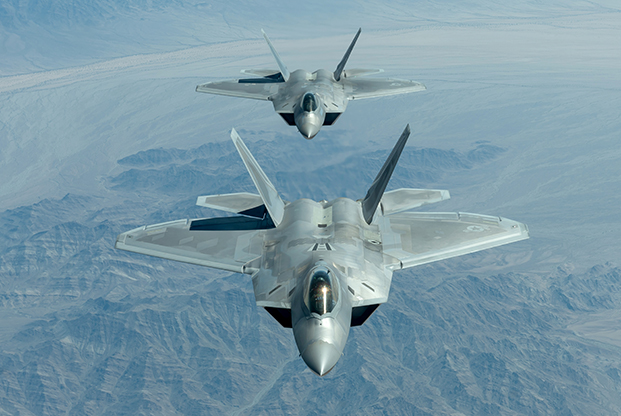 F-22 Demonstration Team Raptors over Northern California, en route to Travis AFB, Calif. The F-22 was optimized for air-to-air dominance and designed to complement the F-35. Photo: 2nd Lt. Samuel Eckholm
F-22 Demonstration Team Raptors over Northern California, en route to Travis AFB, Calif. The F-22 was optimized for air-to-air dominance and designed to complement the F-35. Photo: 2nd Lt. Samuel Eckholm
The United States Air Force today is operating a fighter aircraft inventory on the brink of disaster. Most of the service’s air superiority jets were designed at the conclusion of the Vietnam War, produced in the 1980s, and are ill-suited to meet future threats. Making the situation worse, aircraft such as the F-15C Eagle will wear out their basic structural integrity in the early- to mid-2020s. An immediate change in defense policy and resourcing is required to restore this critical component of US military capability and capacity, made even more urgent given the objectives of the new National Defense Strategy and real-world security challenges.
This was not the scenario the Air Force anticipated. The Air Force intended to acquire more than 750 F-22 Raptors to replace its F-15s, and 1,763 F-35 Lightning IIs to replace its F-16 and A-10 fleets. The F-22 and F-35 were designed to complement each other: The F-22 was optimized for air-to-air dominance, providing the cover for the F-35’s multirole air-to-air and air-to-ground missions. Both aircraft designs incorporated stealth technology and advanced fifth-generation sensors, computing power, and secure communications tools to collaborate across areas of operation.
The end of the Cold War decreased the planned buy of F-22s to just 381, well short of the needed replacements for the F-15. The F-22 program was then prematurely canceled in 2009 at just 186 Raptors—less than half the Air Force’s last stated F-22 requirement—in order to free up funds for the wars in Afghanistan and Iraq. At the time, the expectation was that the Air Force would have hundreds more F-35s by now. Instead, the Air Force has had to extend the life of its F-15 fleet well beyond planned service.
Delayed F-35 production has also meant extending fourth-generation F-16s and A-10 airframes. The average age of the Air Force’s fourth-generation jets now exceeds 25 years. While they remain flyable (albeit with significant structural limitations), they are not survivable in an advanced threat scenario such as a great power competition.
What was once “tomorrow’s threat” is now today’s reality.
With only 186 F-22s and about 200 F-35s to complement its aging fourth-generation fighters, the Air Force has too few fighters to defend the United States in a modern security environment including a potential North Korean conflict occurring simultaneously with a requirement to check Russian revanchist actions in Europe, or Chinese aggression in East Asia.
Yet instead of increasing the buy rate for more low-observable F-35s to support the goals of the new defense strategy, the Department of Defense (DOD) fiscal 2020 budget request seeks to purchase eight F-15EX fighters—aircraft based on a design that dates back to the late 1960s. Even as new-build with upgraded capabilities, these fourth-generation F-15EXs will lack key attributes necessary to survive and operate in the priority advanced threat environments identified in the National Defense Strategy. Low observability, commonly known as stealth, and sensor fusion are not bolt-on capabilities and cannot be retrofitted or modified: They must be designed into an aircraft from Day 1.
Air superiority is a prerequisite to joint operations. Without Air Force contributions, other military services’ capabilities cannot be realized. Ships, ground forces, space and cyber facilities, logistics nodes, and support aircraft are all exceedingly vulnerable to attack from modern weapons. Failure to modernize our air forces with relevant, capable, and survivable aircraft will result in crippling losses in a conflict with a rival such as China or Russia. Recapitalizing the Air Force fighter force with fifth-generation aircraft is fundamental to fielding viable US military power around the globe.
Given those stakes, it is crucial to prioritize the production of fifth-generation fighter aircraft. The US should increase F-35 procurement rates and accelerate investment in the Next-Generation Air Dominance (NGAD) program to make up for its undersized F-22 fleet. Today’sfighter force consists of 82 percent fourth-generation and only 18 percent fifth-generation aircraft. Reversing that balance is the only way to ensure America’s sons and daughters strap into aircraft that can successfully execute their missions against the world’s most challenging threats—and return home safely.
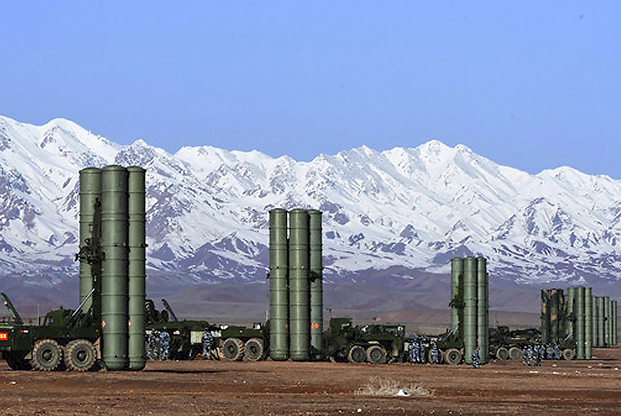 A surface-to-air missile defense system in the desert of northwest China. China and Russia are modernizing their militaries as crises flare around the world. Photo: Liu Chuan/ Chinese Ministry of National Defense
A surface-to-air missile defense system in the desert of northwest China. China and Russia are modernizing their militaries as crises flare around the world. Photo: Liu Chuan/ Chinese Ministry of National Defense
THE THREAT ENVIRONMENT
The National Defense Strategy Commission’s recent assessment of the 2018 National Defense Strategy concluded that America’s hard military power has eroded “to a dangerous degree.” America’s ability to defend its allies, partners, and its own vital interests is increasingly in doubt, the commission stated, and if the US does not act promptly, the consequences will be “grave and lasting.”?
America’s military dominance is waning at the worst time. The reemergence of great power competition means that America faces its greatest strategic challenge since the end of the Cold War, and the rest of the globe is as complex and unstable as it ever has been. China and Russia are asserting their power around the world and modernizing their militaries, regional crises simmer and flare in the Middle East, the Korean Peninsula remains unpredictable, and violent extremists demand US attention.
In the three decades since the fall of the Soviet Union, low-intensity conflicts and counterinsurgency operations created a strategic amnesia regarding what it takes to prevail in high-end combat. During those years, some defense leaders even derided strategies and technologies focused on high-end warfare, dismissing air superiority fighters as “gold-plated” Cold War relics. Not surprisingly, Congressional budget cuts and Pentagon programmatic decisions cost the Air Force more aircraft during this time than any adversary since 1947. From 1990 to 2016, the Air Force total aircraft inventory plunged more than 45 percent, from 9,907 aircraft to 5,369 aircraft.
Over those same three decades, airpower’s successes—first in Operation Desert Storm, then in Operation Allied Force over Serbia and Kosovo—produced a false security that fighters purchased during the Reagan administration would remain viable against well-equipped adversaries in future conflicts. As a result, the air superiority component was cut by almost half, from 3,206 F-4D/Es, F-15A/Cs, and F-16A/Cs in 1990, to just 1,753 F-15Cs, F-15Es, F-16s, F-22s, and F-35s today.
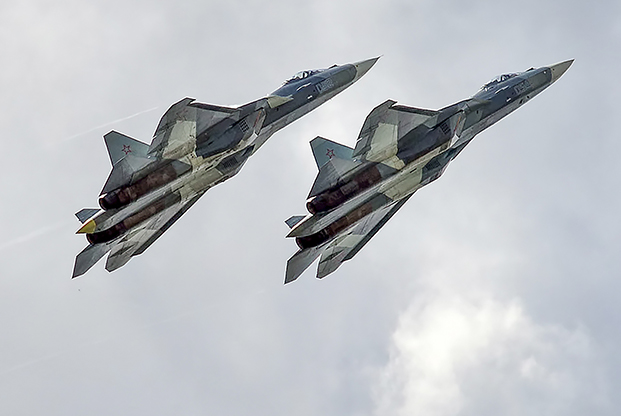 Two Russian Sukhoi Su-57 fifth-generation fighters in 2017. Russia has narrowed the gap between its capabilities and those of the US. Photo: Anna Zvereva
Two Russian Sukhoi Su-57 fifth-generation fighters in 2017. Russia has narrowed the gap between its capabilities and those of the US. Photo: Anna Zvereva
UNDERSTANDING FIFTH-GENERATION ATTRIBUTES
Why, then, if the US military is facing a critical military capability gap, is there still a consistent assault on fifth-generation airpower? What is driving the notion that 20th century aircraft can prevail in 21st century warfare
One reason for believing that legacy aircraft are “good enough” is experience. For the past 30 years, these aircraft have indeed been successful at every mission-set assigned to them. After the spectacular performance of fourth-generation aircraft in Operation Desert Storm, no adversary has posed a serious air defense challenge to US airpower in a military campaign. Since 1992, only four Air Force fighters have been shot down in combat by enemy surface-to-air missile systems.
That very success has bred a broad sense of complacency and a lack of concern about the potential vulnerability of US military power: Even the B-2 program was ended prematurely. Of the 132 stealth bombers planned, only 21 were procured. Just 20 remain in the inventory, forcing the Air Force to go to great lengths to preserve those aircraft because nothing else can match their essential range, payload, and penetration capability. For example, when a B-2 experienced a catastrophic engine fire in 2010, the Air Force invested over $105 million over four years to rebuild major sections of the jet by hand. With such an undersized and uniquely capable fleet, Air Force leaders had no choice.
Because fourth-generation fighters have been dubbed “good enough” for the last 30 years, the vast improvements provided by fifth-generation technologies are not sufficiently understood by policymakers. Modernization has incrementally increased the capabilities of fourth-generation aircraft through improvements in sensors, displays, pods, and increased processing. Yet, fourth- generation aircraft, even with advanced avionics modifications like those on the F-15EX, are simply not survivable against modern threats.
These airplanes lack three critical attributes:
- All-aspect stealth and superior aerodynamic performance
- Advanced automated sensors and information fusion
- The synergy of stealth, fused information, and integrated automated processing.
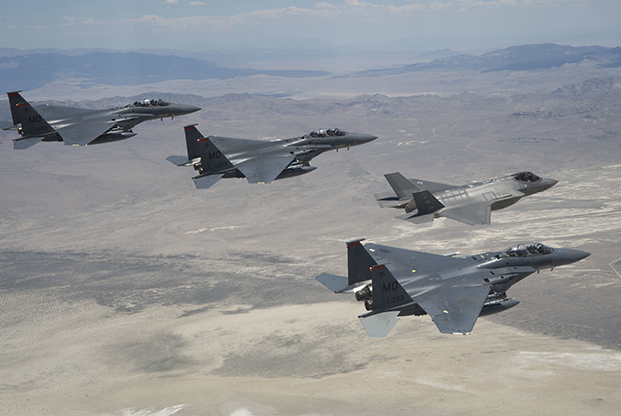 Lt. Gen. Mark Kelly, 12th Air Force Commander, in an F-35 leads a formation of F-15Es over the Utah Test and Training Range in July 2018. The US should increase F-35 procurement rates to make up for USAF’s undersized F-22 fleet. Photo: A1C Codie Trimble
Lt. Gen. Mark Kelly, 12th Air Force Commander, in an F-35 leads a formation of F-15Es over the Utah Test and Training Range in July 2018. The US should increase F-35 procurement rates to make up for USAF’s undersized F-22 fleet. Photo: A1C Codie Trimble
STEALTH AND SURVIVABILITY
Stealth is the attribute for which fifth-generation aircraft are best known. Visually striking, the strange angled facets of the F-117, the smooth, blended flying wing of the B-2, or the canted angles of the F-22 and F-35 are the result of highly engineered radar-deflecting designs. No other fifth-generation attributes would matter if the underlying stealth wasn’t part of the package. Stealth is the cost of entry into anti-access/area-denial (A2/AD) threat environments, where modern air defenses turn fourth-generation penetrators into stand-off assets because of their advanced radars and missile systems. If legacy fighters cannot enter an advanced threat environment, then they cannot execute their mission.
Understanding how radar interacts with aircraft is critical to appreciating the value of stealth in war. The radar cross section (RCS) of an aircraft is the magnitude of radar energy from a threat system that reflects off an aircraft.This reflection is not uniform. As radar energy bounces off the surface of the aircraft it may return straight back to the radar receiver, reflect on an axis different from the original energy source, or scatter in a variety of directions. Evidence of an object reflecting energy in the radar field of view is termed a “radar or target return.” It can “bloom” or “fade” depending on the angle of attack. The challenge facing aircraft designers is to create a low-observable (stealthy) signature that does not increase in strength or “bloom” dramatically from any viewing angle, either horizontally or vertically. Reducing reflected radar energy requires all sensors, weapons, and fuel to be housed internally, because any external store becomes a major radar reflector, even when shaped and coated to reduce its radar signature.
Early on, designers had to make compromises between aerodynamic performance and stealth, because the multi-faceted shape required to scatter radar energy runs counter to the design considerations needed to maximize aerodynamic maneuverability. But neither the F-22 nor F-35 compromise performance to become “very low observable (VLO).” Thanks to advanced computer processing, lessons learned from earlier stealth designs, and innovative radar-absorbing materials, these fifth-generation aircraft deliver “all-aspect stealth” while still exceeding the air combat maneuverability of fourth-generation fighters. As a result, neither the F-22 nor F-35 have to be predictable in their flight path maneuvering. In a dense and highly dynamic threat environment, they can aggressively react to threats or prosecute targets.
Importantly, stealth is much more than minimizing the RCS of an aircraft. Passive sensors have improved in sensitivity and capability over the years, making traditional omni-directional radios a major vulnerability. Fifth-generation aircraft must have low probability of detection (LPD) and low probability of intercept (LPI) radios and data links. Directionally focused with low power and narrow beam width, LPD and LPI transmissions make it extremely difficult for adversaries to exploit fifth-generation aircraft radios and data links for targeting or even early warning. Fifth-generation aircraft automatically manage the power and direction of their own sensors and rely upon passive sensors as well.
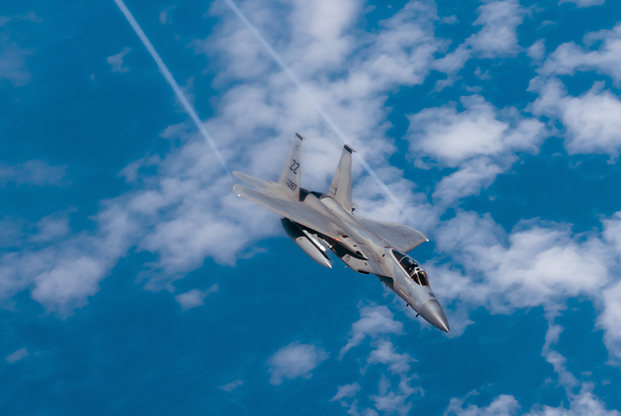 An F-15C on a training exercise out of Kadena AB, Japan. F-15Cs will wear out their basic structural integrity by the early- to mid-2020s. Photo: A1C Matthew Seefeldt
An F-15C on a training exercise out of Kadena AB, Japan. F-15Cs will wear out their basic structural integrity by the early- to mid-2020s. Photo: A1C Matthew Seefeldt
BATTLESPACE AWARENESS, DECISION SUPERIORITY
A fifth-generation aircraft’s game-changing characteristics are also attributable to its power to gather, process, and harness information. While some fourth-generation aircraft may feature elements of this technology, the sheer volume and quality of information available to a fifth-generation pilot dramatically increases combat mission effectiveness. Combining data from off-board sources and the aircraft’s own array of multispectral active and passive sensors, a powerful central computer uses sophisticated algorithms to correlate, compare, evaluate, and fuse information into a highly accurate, real-time situational awareness picture. According to two experienced fifth-generation Air Force pilots, the power of fifth-generation aircraft to gather, process, exploit, and share information “turns operators of these advanced aircraft into mission commanders, rather than having them focus on managing and operating subsystems.”
Fourth-generation aircraft have loosely federated sensors—their radar systems are separate from data links, which are also separate from electronic warfare systems and other components. In a fourth-generation aircraft, pilots must not only manage each sensor and system individually, but also interpret the information from each sensor and system and make sense of the whole—all while flying and maneuvering the aircraft.
But the advanced sensors in fifth-generation aircraft are automated and require little to no active control from the pilot. Sensor data is automatically shared with other aircraft via data link, allowing a collaborative approach where the aircraft automatically correlate, compare, and fill in the best information with other aircraft in their flight. The result is a robust, common battlespace picture shared among all flight members. With this enhanced situational awareness, pilots can better execute threat avoidance, target detection, direction of forces, engagement decisions, and other command actions. In short, fifth-generation aircraft provide superior information and decision advantage.
“We have more information at our fingertips than other aircraft,” one F-22 pilot who flew sorties during Operation Inherent Resolve over Syria explained. “We have an easier time making big decisions.”
Although modernization has made some legacy aircraft more capable, fifth-generation information fusion cannot be retrofitted to legacy airframes. Fifth-generation information and sensor fusion must be built into the design of an aircraft from the beginning.
STEALTH AND INFORMATION
Combining stealth with information and decision superiority transforms battlespace awareness into superior initiative and maneuver, providing a true asymmetric advantage for fifth-generation aircraft over older aircraft designs.
This battlespace initiative is what stealth skeptics tend to overlook. Stealth increases the aircraft’s probability of survival while at the same time making defense against fifth-generation aircraft much more difficult for the enemy. While older, legacy stealth aircraft required a so-called “black line” of a predetermined flight path to thread in between threats, fifth-generation fighters have freedom of maneuver because they are both stealthy and they know where threats are located. “I see radars. I see airplanes. I see surface-to-air missiles, and the jet knows where those things are and tells me,” an F-22 pilot said of his experience flying combat sorties over Syria in Operation Inherent Resolve. “So, I have a picture of the battlespace.”
With that high degree of battlespace awareness, a fifth-generation pilot can turn stealth into an offensive attribute for attack.
Stealth, therefore, is not just a defensive survival attribute; it’s a prerequisite to successful offensive operations, combining the advantage of surprise with increased lethality.
UNDERSTANDING THE COST AND VALUE OF STEALTH
Unfortunately, multiple oversight agencies, including the respected Congressional Budget Office (CBO), continue to treat fourth- and fifth-generation aircraft as if they are interchangeable. This leads to questionable analytical outcomes given outdated assessment models. One recently released CBO report presented startling options to offset a hypothetical cancellation of the F-35: Fill the gap by purchasing legacy fighters like the F-16 and F/A-18. The same report also floated the idea of divesting the entire F-22 fleet without suggesting how to deliver comparable capability.
These are poorly reasoned options and false choices. Treating all fighter aircraft as similar commodities, regardless of capabilities, reveals a dangerous disconnect between the threats America faces and the Air Force America needs.
Additionally, most—if not all—of DOD’s focus on unit and sustainment costs per aircraft type ignore the actual costs necessary to accomplish desired objectives against the priority threats of the National Defense Strategy. For example, fifth-generation aircraft do not require the large mission package of additional specialized support aircraft to jam radars, defeat enemy fighters, and negate surface-to-air-missile systems that fourth-generation aircraft do. This mission support package is not part of DOD’s cost analysis, but it should be considered to make any cost assessment relevant. Meeting actual mission objectives is what matters, and cost-per-effect is a more relevant metric than cost per aircraft or cost per flying hour.
Including support asset requirements in an “apples-to-apples” cost-effectiveness assessment shows that fifth-generation aircraft are significantly more cost-effective than fourth-generation aircraft. Additional force-protection packaging for fourth-generation fighters also drive up requirements for additional pilots and support personnel, along with additional mission support aircraft such as air-to-air refueling tankers. Against peer threats, the cost of achieving a desired effect with fourth-generation aircraft is dramatically higher than the same effect delivered from fifth-generation aircraft. In a simple cost analysis, the return on investment is substantially greater with fifth-generation aircraft.
FIXING THE CAPABILITY AND CAPACITY GAP
In testimony last year to the Senate Armed Services Committee, Air Force Chief of Staff Gen David L. Goldfein and then-Air Force Secretary Heather Wilson addressed the health of the Air Force. Service advantage and readiness shrank, they said, “due to the longest continuous stretch of combat in our nation’s history, coupled with years of inconsistent and insufficient funding.” All the while, China and Russia have closed gaps in both capacity and capability. The result, they added, has been “an overstretched and under-resourced United States Air Force.”
For three decades, the Air Force has divested capabilities to help meet budget requirements, fueling today’s recapitalization crisis. The service is now too small and risks getting smaller as aircraft age out of service. To stabilize the force and meet the objectives of the National Defense Strategy, the Air Force must acquire at least 72 fighters per year. Failure to sustain that rate risks a force that does not have the necessary capacity to meet our national security needs.
However, the issue is not simply about quantity of aircraft, but also about the capability of those aircraft. As the Chairman of the Joint Chiefs of Staff, Marine Gen. Joseph Dunford, said on May 29, “Where you have to make a choice between capacity and capability, I would go with capability.”
Air Force written testimony to Congress makes that point plainly, stating “to meet emerging worldwide threats across the spectrum of conflict the cornerstone of the Air Force [must be a] shift from 4th/5th-generation to a 5th/6th-generation fleet.” Increasing the procurement rate of fifth-generation aircraft and accelerating NGAD development are the paths necessary to ensure this goal is met.
While some defense observers suggest that the F-15EX program will come from additive funds, history suggests otherwise over the long haul. Budget plus-ups of this sort disappear when defense budgets decline, but the mandate to pay the bill remains. Given today’s ballooning federal deficits, economic uncertainty, and mounting pressure from mandatory federal spending accounts, it is unlikely that current spending levels can be sustained. Further looming over the budget is a sharply divided and gridlocked Congress, with the growing possibility of a return to sequester-level spending. Either path could lead to a competition between the F-35 and F-15EX for funding, with severe ramifications for the F-35.
If the F-15EX becomes a program of record and funds are appropriated for production, it is likely that any future budget trade-offs could come out of planned F-35 purchases. This would reduce F-35 production rates, pushing up the cost per plane. If that happens, new doubts will emerge about F-35 program sustainability and affordability, yielding further cuts and further price hikes. This is what Washington calls a “death spiral,” a self-reinforcing dynamic that leads to an inevitable early end to expensive programs.
Recently departed Secretary of the Air Force Heather Wilson pushed back against the trade-off of F-35 for F-15EX, prudently explaining: “If the budget gets crunched in the out years, you can’t start trading off and saying we’re going to keep open an F-15 line. We’re not going to trade off fifth-generation for fourth-generation.” In reality, however, once the F-15EX becomes a line item in the budget, that decision will not be in the hands of the Air Force. Congress will make that call, with local politics, not prudent planning, the foremost driver in the debate.
It is ironic that it is because the F-22—itself a victim of the death spiral—was prematurely canceled that an F-15EX is even being considered. The only difference this time is that dramatic reductions to the Air Force F-35 program would also impact the US Navy, the US Marine Corps, and a host of allied militaries also buying the F-35.
While each military service will need new capabilities and capacities to fulfill their obligations, none of those investments will matter if the Air Force is unable to provide the airpower foundation upon which joint combat operations depend. America must now have the resolve to rebuild its Air Force to be able to defeat advanced adversaries as outlined in the National Defense Strategy. The following actions are prudent means to accomplish this objective:
- Ensure fifth-generation aircraft and NGAD receive top priority for finite budget resources. Procuring F-15EXs cannot come at the cost of these essential modernization programs
- Increase the F-35A production rate to 80 aircraft per year beginning in fiscal year 2021
- Reduce the ratio of fourth- to fifth-generation fighters from 82/18 to 50/50 as rapidly as possible
- Encourage allies to buy fifth-generation aircraft
- Eliminate “aircraft unit cost” as a decision metric on programs and replace it with a “cost-per-effect” model
- Replace the simplistic cost-per-flying-hour metric with the more holistic metric of total annual cost per aircraft.
America’s sons and daughters will fly into harm’s way in whatever combat aircraft their nation procures. We must do everything in our power to ensure those aircraft can get the job done in the face of an increasingly challenging threat, while also ensuring the airmen inside will return home safely from their missions. That requires investing in modern, capable, and relevant advanced aircraft designs and technology.
___
Lt. Gen. David Deptula is the dean of the Mitchell Institute for Aerospace Studies, Maj Gen. Lawrence Stutzriem is Mitchell’s director of research, and Heather Penney is a senior resident fellow at Mitchell. This article is adapted from the Mitchell Institute Policy Paper, "Ensuring the Common Defense: The Case for Fifth Generation Airpower," which can be downloaded in its entirety at www.mitchellaerospacepower.org.